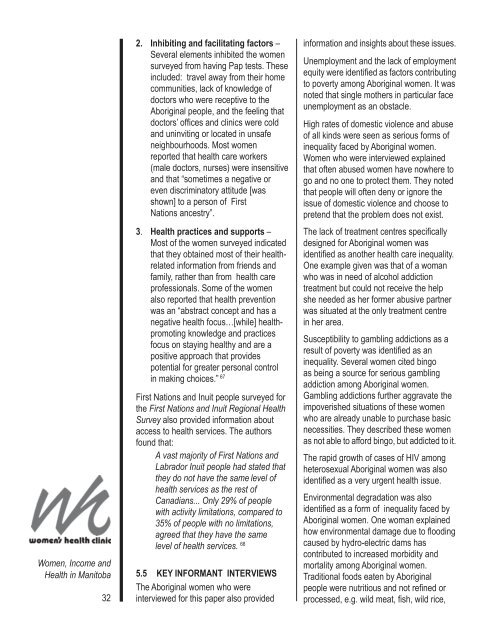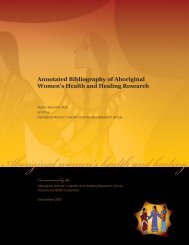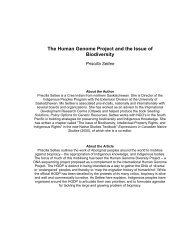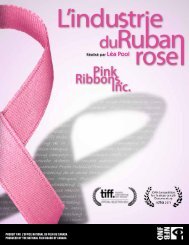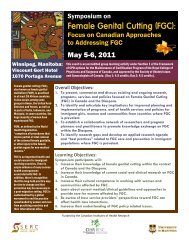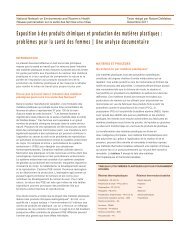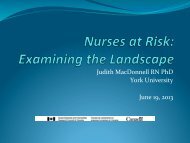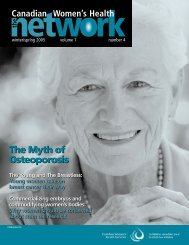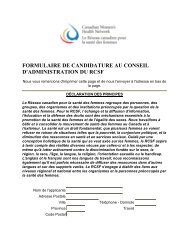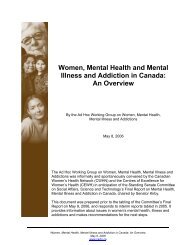here. - Canadian Women's Health Network
here. - Canadian Women's Health Network
here. - Canadian Women's Health Network
- No tags were found...
Create successful ePaper yourself
Turn your PDF publications into a flip-book with our unique Google optimized e-Paper software.
Women, Income and<strong>Health</strong> in Manitoba322. Inhibiting and facilitating factors –Several elements inhibited the womensurveyed from having Pap tests. Theseincluded: travel away from their homecommunities, lack of knowledge ofdoctors who were receptive to theAboriginal people, and the feeling thatdoctors’ offices and clinics were coldand uninviting or located in unsafeneighbourhoods. Most womenreported that health care workers(male doctors, nurses) were insensitiveand that “sometimes a negative oreven discriminatory attitude [wasshown] to a person of FirstNations ancestry”.3. <strong>Health</strong> practices and supports –Most of the women surveyed indicatedthat they obtained most of their healthrelatedinformation from friends andfamily, rather than from health careprofessionals. Some of the womenalso reported that health preventionwas an “abstract concept and has anegative health focus…[while] healthpromotingknowledge and practicesfocus on staying healthy and are apositive approach that providespotential for greater personal controlin making choices.” 67First Nations and Inuit people surveyed forthe First Nations and Inuit Regional <strong>Health</strong>Survey also provided information aboutaccess to health services. The authorsfound that:A vast majority of First Nations andLabrador Inuit people had stated thatthey do not have the same level ofhealth services as the rest of<strong>Canadian</strong>s... Only 29% of peoplewith activity limitations, compared to35% of people with no limitations,agreed that they have the samelevel of health services. 685.5 KEY INFORMANT INTERVIEWSThe Aboriginal women who wereinterviewed for this paper also providedinformation and insights about these issues.Unemployment and the lack of employmentequity were identified as factors contributingto poverty among Aboriginal women. It wasnoted that single mothers in particular faceunemployment as an obstacle.High rates of domestic violence and abuseof all kinds were seen as serious forms ofinequality faced by Aboriginal women.Women who were interviewed explainedthat often abused women have now<strong>here</strong> togo and no one to protect them. They notedthat people will often deny or ignore theissue of domestic violence and choose topretend that the problem does not exist.The lack of treatment centres specificallydesigned for Aboriginal women wasidentified as another health care inequality.One example given was that of a womanwho was in need of alcohol addictiontreatment but could not receive the helpshe needed as her former abusive partnerwas situated at the only treatment centrein her area.Susceptibility to gambling addictions as aresult of poverty was identified as aninequality. Several women cited bingoas being a source for serious gamblingaddiction among Aboriginal women.Gambling addictions further aggravate theimpoverished situations of these womenwho are already unable to purchase basicnecessities. They described these womenas not able to afford bingo, but addicted to it.The rapid growth of cases of HIV amongheterosexual Aboriginal women was alsoidentified as a very urgent health issue.Environmental degradation was alsoidentified as a form of inequality faced byAboriginal women. One woman explainedhow environmental damage due to floodingcaused by hydro-electric dams hascontributed to increased morbidity andmortality among Aboriginal women.Traditional foods eaten by Aboriginalpeople were nutritious and not refined orprocessed, e.g. wild meat, fish, wild rice,


